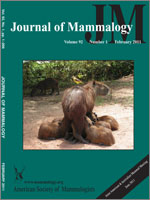Movements away from the natal or home territory are important to many ecological processes, including gene flow, population regulation, and disease epidemiology, yet quantitative data on these behaviors are lacking. Red foxes exhibit 2 periods of extraterritorial movements: when an individual disperses and when males search neighboring territories for extrapair copulations during the breeding season. Using radiotracking data collected at 5-min interfix intervals, we compared movement parameters, including distance moved, speed of movement, and turning angles, of dispersal and reproductive movements to those made during normal territorial movements; the instantaneous separation distances of dispersing and extraterritorial movements to the movements of resident adults; and the frequency of locations of 95%, 60%, and 30% harmonic mean isopleths of adult fox home territories to randomly generated fox movements. Foxes making reproductive movements traveled farther than when undertaking other types of movement, and dispersal movements were straighter. Reproductive and dispersal movements were faster than territorial movements and also differed in intensity of search and thoroughness. Foxes making dispersal movements avoided direct contact with territorial adults and moved through peripheral areas of territories. The converse was true for reproductive movements. Although similar in some basic characteristics, dispersal and reproductive movements are fundamentally different both behaviorally and spatially and are likely to have different ultimate purposes and contrasting effects on spatial processes such as disease transmission.
How to translate text using browser tools
16 February 2011
Behavioral and spatial analysis of extraterritorial movements in red foxes (Vulpes vulpes)
Carl D. Soulsbury,
Graziella Iossa,
Philip J. Baker,
Piran C. L. White,
Stephen Harris
ACCESS THE FULL ARTICLE

Journal of Mammalogy
Vol. 92 • No. 1
February 2011
Vol. 92 • No. 1
February 2011
animal movement
contact rates
disease transmission
DRAP
gene flow




